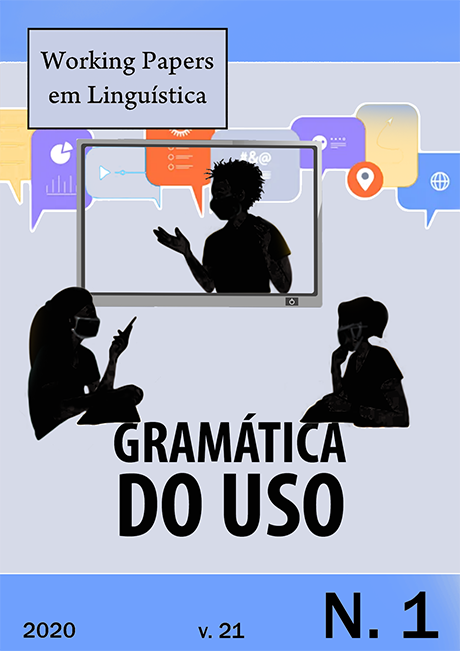“Alto lá”: a construcionalização de um marcador discursivo na língua portuguesa
DOI:
https://doi.org/10.5007/1984-8420.2020v21n1p17Resumen
Investigamos neste artigo a trajetória que leva alto lá a se convencionalizar como membro da classe dos marcadores discursivos do português, em subfunção refreador-argumentativa. Adotando a Linguística Funcional Centrada no Uso, nos termos de Traugott e Trousdale (2013), Bybee (2010; 2015) e Hilpert (2014), entre outros, identificamos três motivações distintas que concorrem para a construcionalização de alto lá: a) as histórico-sociais, devido à origem bélica do termo alto; b) as cognitivas, relativas à conceptualização metafórica DISCUSSÃO É GUERRA, de acordo com Lakoff e Johnson (2003); c) as estruturais, que se referem tanto ao cline contextual, conforme Diewald e Smirnova (2012), em que se registram os micropassos que conduzem à construcionalização de alto lá como marcador discursivo, como também as de base analógica, em consonância com Bybee (2010) e Fischer (2009), por meio das quais alto lá, via melhor encaixe, é fixada a partir do esquema já formado por elemento indutor e afixoide locativo. Concluímos que, uma vez convencionalizada como microconstrução, [alto lá]RA concorre para reconfiguração do esquema [VindutAfixLoc]MD, que passa a ser codificado como [Indut AfixLoc]MD. Devido a essa reconfiguração, novos links são criados em que não só verbos, como também frases nominais, advérbios, entre outros, caracterizados como indutores, passam a compor a subparte nuclear da construção. A investigação tem viés pancrônico, conjugando abordagem diacrônica e sincrônica, partindo de análise qualitativa e quantitativa.
Citas
ANDERSEN, H. Actualization and the (uni)directionality. In Henning Andersen (ed). Actualization: Linguistic change in progress. Amsterdam: Benjamins, 2001, p. 225-248.
BLUTEAU, R. Vocabulário portuguez & latino. Lisboa: Officina de Pascoal da Sylva, 1716.
BOOIJ, G. Morphology in construction grammar. In: HOFFMANN, T.; TROUSDALE, G. (eds.). The oxford handbook of construction grammar. Oxford: Oxford University Press, 2013, p.255-273.
BYBEE, J. Language, usage and cognition. New York: Cambridge University Press, 2010.
BYBEE, J. Language change. Cambridge: Cambridge University Press, 2015.
CROFT, W. Radical construction grammar: syntactic theory in typological perspective. Oxford: Oxford University Press, 2001.
DIEWALD, G. A model for relevant types of contexts in grammaticalization. In: WISHER, Ilse; DIEWALD, G. (eds). New reflections on grammaticalization. Amsterdan: John Benjamins, 2002, p.103-120.
DIEWALD, G. Contexts types in grammaticalization as constructions. In: Special volume 1: Constructions all over – case studies and theoretical implications. Dusseldorf, 2006. Disponível em: www. constructions-online.de:009-4-6860. Acesso em: 10 de mar. 2019.
DIEWALD, G; SMIRNOVA, E. “Paradigmatic integration”: the fourth stage in an expanded grammaticalization scenario. In: DAVIDSE, K. at al (eds). Grammaticalization and language change – new reflections. Amsterdam/Philadelphia: John Benjamins, 2012, p.111-131.
FISCHER, O. Grammaticalization as analogically driven change? In: Vienna English Working Papers, vol. 18, n. 2, 2009. p.3-23.
GOLDBERG, A. Constructions: a construction grammar approach to argument structure. Chicago: University of Chicago Press, 1995.
GOLDBERG, A. Constructions at work: the nature of generalization in language. Oxford: Oxford University Press, 2006.
GOLDBERG, A. Explain me this: creativity, competition and the partial productivity of constructions. Princeton and Oxford: Princeton University Press, 2019.
HEINE, B.; KALTENBÖCK, G.; KUTEVA, T. On the rise of discourse markers. Researchgate. Preprint, june, 2019, DOI: 10.13140/RG.2.2.31703.73129. Disponível em: htps://www.researchgate.net/publication/333783353. Acesso em: 27 de jun. 2019.
HILPERT, M. Construction grammar and its application to English. Edinburgh: Edinburgh University Press, 2014.
HIMMELMANN, N. P. Lexicalization and grammaticalization: opposite or orthogonal? In: BISANG, HIMMELMANN & WIEMER (eds.). What makes grammaticalization? A look from its fringes and its components. Berlin: Mouton de Gruyter, 2004, p.21-42.
LAKOFF, G.; JOHNSON, M. Metaphors we live by. Chicago: The University of Chicago Press, 2003.
LANGACKER, R. Cognitive Grammar: A basic introduction. New York: Oxford University Press, 2008.
OLIVEIRA, M. R.; ARENA, A. B. O viés funcional do pareamento simbólico função < > forma na abordagem construcional da gramática. Soletras, no. 37, p. 30-58, 2019.
OLIVEIRA, M. R.; CEZARIO, M. M. (orgs). Funcionalismo linguístico: vertentes e diálogos. Niterói: Editora da UFF, 2017.
ROSA, F. S. L. A mesoconstrução marcadora discursiva refreador-argumentativa: uma análise cognitivo-funcional. 216 fls. Tese (Doutorado em Estudos de Linguagem) Instituto de Letras, Universidade Federal Fluminense, Niterói: RJ, 2019.
ROSÁRIO, I. C.; OLIVEIRA, M. R. Funcionalismo e abordagem construcional da gramática. Alfa, 2016, n. 60, v. 2, p. 233-259.
TEIXEIRA, A. C. M. A construção verbal marcadora discursiva VLocMD: uma análise funcional centrada no uso. 297 fls. Tese (Doutorado em Estudos de Linguagem) Instituto de Letras, Universidade Federal Fluminense, Niterói: RJ, 2015.
TRAUGOTT, E. Grammaticalization, constructions and the incremental development of language: Suggestions from the development of degree modifiers in English. In Regine Eckardt, Gerhard Jäger, and Tonjes Veenstra (eds). Variation, Selection, Development--Probing the Evolutionary Model of Language Change. Berlin/New York: Mouton de Gruyter, 2008. p. 219-250.
TRAUGOTT, E; DASHER, R. Regularity in semantic change. Cambridge: Cambridge University Press, 2005.
TRAUGOTT, E. C.; TROUSDALE, G. Constructionalization and constructional changes. Oxford: Oxford University Press, 2013.
Descargas
Publicado
Número
Sección
Licencia
Os direitos autorais de trabalhos publicados são dos autores, que cedem à Revista Working Papers em Linguística o direito de publicação, ficando sua reimpressão, total ou parcial, sujeita à autorização expressa da Comissão Editorial da revista. Deve ser consignada a fonte de publicação original. Os nomes e endereços de e-mail neste site serão usados exclusivamente para os propósitos da revista, não estando disponíveis para outros fins.
The names and email addresses entered in this journal site will be used exclusively for the stated purposes of this journal and will not be made available for any other purpose or to any other party.
Esta obra está licenciada sob licença Creative Commons - Atribuição-NãoComercial- 4.0 Internacional.


